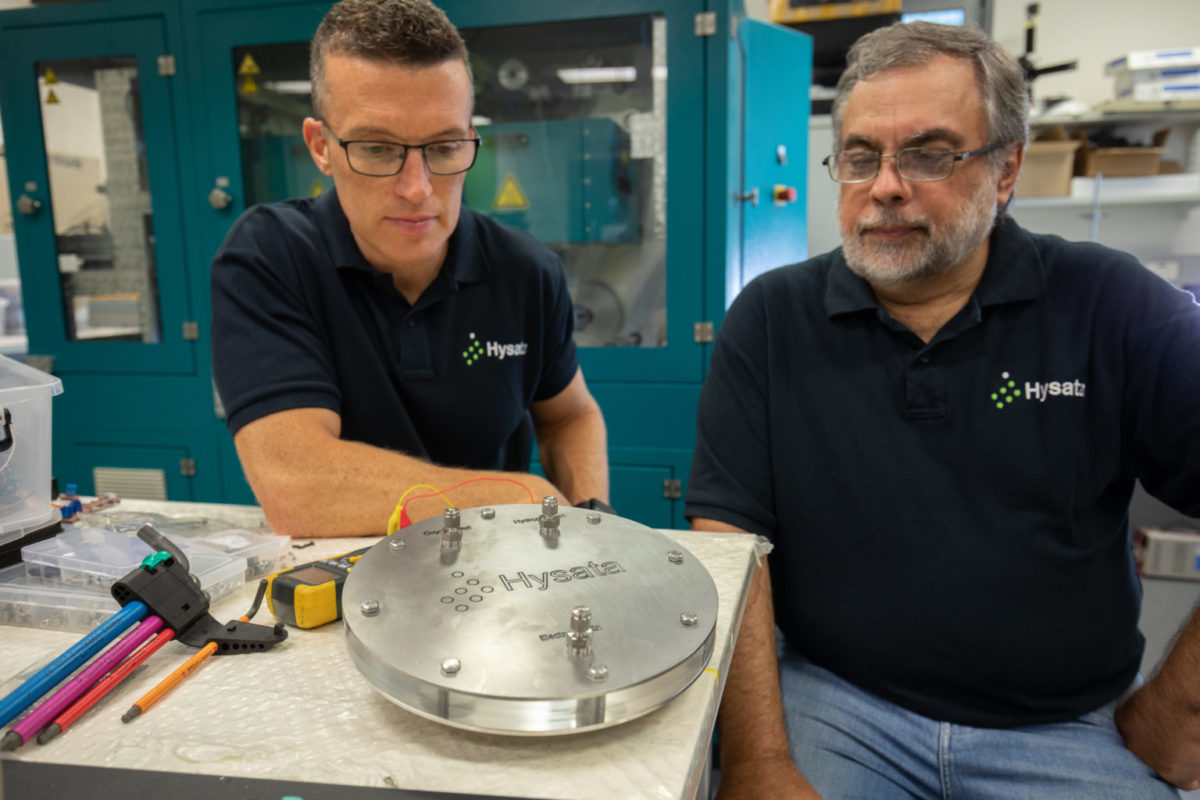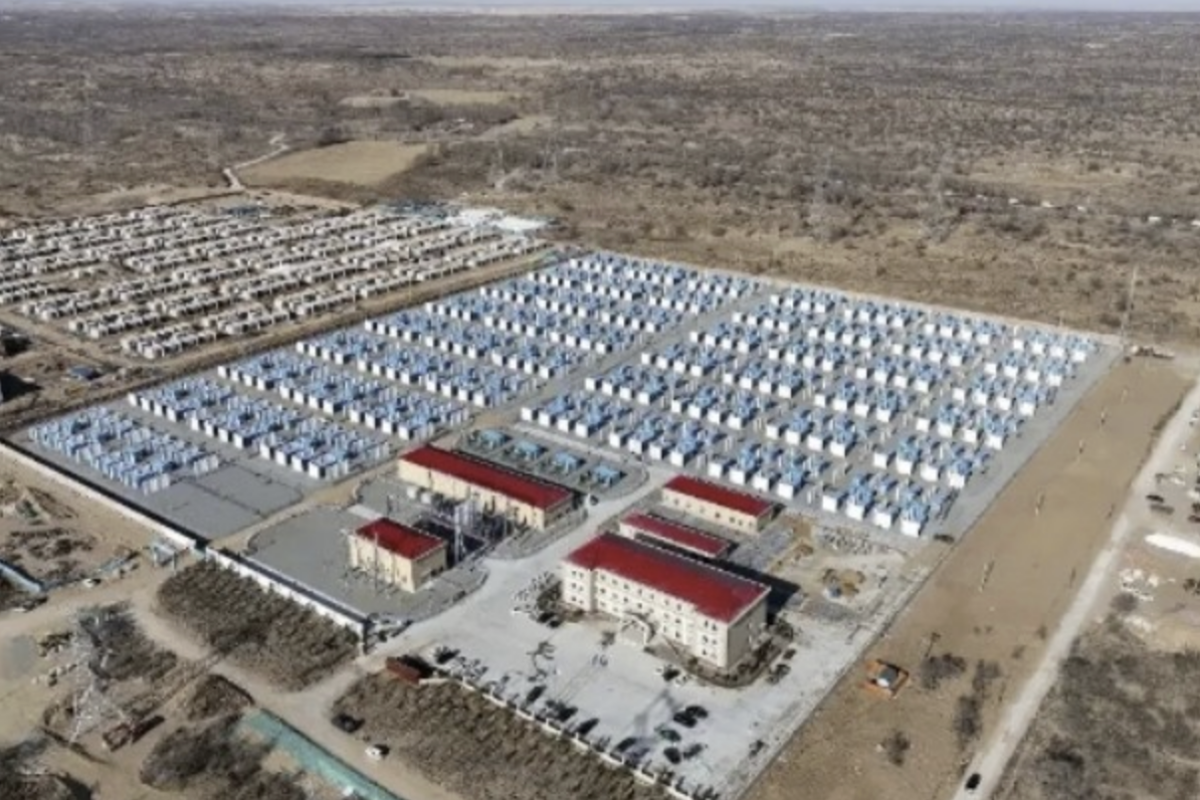New South Wales company Hysata is on track to commercialize the world’s most efficient electrolyzer, capable of producing green hydrogen for less than US$1.5 per kilogram by the ‘mid 2020s,’ it says. Moreover, the company believes it can reach gigawatt scale hydrogen production within a similar timeframe, saying its design is simple and suitable for mass manufacture today.
The company was born out of an electrolysis breakthrough made at the University of Wollongong, south of Sydney, around three years ago. There, researchers led by Gerry Swiegers discovered hydrogen could be produced far more efficiently using capillary-fed electrolysis.
This was verified in a paper published today in peer-reviewed scientific journal Nature, which found the capillary-fed electrolyzer could produce green hydrogen from water at 98% cell energy efficiency.

The Hysata electrolyzer consumes 40.4kWh of energy for every kilogram of hydrogen it produces. The Nature paper noted commercial electrolysis cells tend to use around 47.5kWh/kg, though Hysata CEO Paul Barrett claimed it was closer to 52.5kWh/kg. This equates to around 75% system-level efficiency, whereas the Hysata system claims a total efficiency of 95%.
This 20% efficiency boost has enabled the massive cost reduction Hysata says it’s only a few years away from making a reality. “You really collapse the project economics through that efficiency lever,” Barrett told pv magazine Australia. The academic added the company has “a simplified system which really reduces the cost quite substantially.”
Cost
Barrett didn’t want to commit publicly to the price of the Hysata electrolyzer, but said the company is in conversation with around 30 “name brand companies,” needing green hydrogen, who are “thrilled” about the economics.
“Our technology will enable hydrogen production of below US$1.50 per kilogram by the mid-2020s, meeting Australian and global cost targets much earlier than generally expected,” Barrett said.
Barrett said the company is busy building its pilot line of electrolyzers in a house near Wollongong now. “We’re building a huge test capacity, like, today,” he said. He is hoping to begin testing them in parallel within the next few months, with plans to ramp up the pilot line in 2023.

From pilot scale, the company wants to jump directly into gigafactories. To enable this, Hysata will grow its team of 20 engineers significantly this year.
“We are planning to have systems in the field by 2025,” Barrett said.
“I’ve got plates working today at the efficiency and performance that we’ve got on that paper,” he added, referring to the study in Nature, and adding: “our next thing is to basically string lots of those together, not unlike the way you’d string multiple solar modules together. We’ll connect them in series and that becomes our stack.”
The company “certainly” plans to keep its manufacturing in Australia, Barrett said, possibly remaining in Wollongong – which is right next door to the proposed Port Kembla hydrogen hub.
“This can be an era defining company for Australia,” the CEO said, noting that Australia imports the vast majority of its renewables equipment today, such as solar panels and wind turbines. “There’s a real opportunity to build sovereign manufacturing capacity here in Australia and export it to the world,” he added.

This very much aligns with Matt Kean’s plan, the state’s environment and energy minister as well as treasurer. In February, he announced AU$250 million (US$180 million) in funding to boost locally manufactured renewable energy content and a further AU$300 million (US$216 million) to build a renewables-powered manufacturing base including renewable hydrogen.
The company is the “first in the world” to commercialize a capillary-fed electrolyzer, according to Barrett. To date, he says, electrolyzer technology has been “too inefficient and too complex” to make green hydrogen attractive. Hindering efficiency in electrolyzer cells is resistance, which has typically come from bubbles which are non-conducting, and mask electrodes.

Barrett said the research team at the University of Wollongong “basically looked at that problem with a blank sheet of paper and really tried to understand where all the resistance is, inside the cell.” That exercise led to the invention of capillary-fed electrolysis which eliminates these bubbles and boosts efficiency.
This leads to a “double whammy benefit on the economics,” Barrett says, because hydrogen projects would need less renewables to get the same hydrogen output, saving on capital outlays while also only needing to purchase a smaller electrolyzer.
Electrolyzer details
The company’s electrolyzer is fives times smaller than a traditional alkaline electrolyzer, Barrett says, and contains 20 times less liquid. It fits inside a six-meter shipping container and can be moved by forklift for easy transportation, he added. “So we’ve got a drastically simplified balance of plan.”
Hysata’s electrolyzer cell frame is made using a scalable, low cost and mass manufacturing technique – making the product nimble so it can get to market as quickly as possible.
“We’re one of the few, if not the only, electrolyzer from time zero, to be mass manufacturable,” Barrett said.

Hysata, a start-up, only officially launched in June last year. It kicked off with AU$5 million (US$3.6 million) in seed funding from the UK-based IP Group, with AU$750,000 (US$539,000) from the government-owned Clean Energy Finance Corporation (CEFC).
Swieger, who led the University of Wollongong ARC Centre of Excellence for Electromaterials Science research, has since become Hysata’s chief technology officer.
This content is protected by copyright and may not be reused. If you want to cooperate with us and would like to reuse some of our content, please contact: editors@pv-magazine.com.




They should read a little thermodynamics.fthis is a great way to way lose 60+% of green electricity
We need gravity storage systems for load control
I’m assuming you’re referring to “round-trip” efficiency with that figure, although I’m unaware of any proven result in thermodynamics that sets such an efficiency limit. Gravity systems are also excellent if done in a cost effective manner, but there is still the problem of energy transmission. Renewable chemical energy storage systems have the advantage that existing oil transportation networks can be adapted to hydrogen or other electrochemical systems.
Ideally, chemical energy will eventually be produced directly from sunlight without the inefficiency of photovoltaics. Though down the road, the storage and transportation networks needed for that are a strong incentive to build those out now even if current efficiency levels might not on their own warrant that just yet. Thus it makes sense to continue to pursue advances in this area and build out infrastructure since it will eventually be needed.
Electrical grids are the weakest link of all energy distribution networks and do not represent the future of energy. Distributed PV systems still rely on that fixed infrastructure as economy of scale and lack of property ownership by many will make tech such as hydrogen or flow batteries more widespread as time goes on. Those systems simply scale better with greater overall reliability once they no longer rely on electricity as an intermediate.
If this system is as efficient as claimed, and can produce hydrogen at high pressure, then the round trip efficiency could increase to 70% or so.
Not as good as pupmed storage (abouit 90%) but available anywhere. Better than similar CAES or Liquid Air.
I think the main benefiot though will be on providing hydrogen for other applications, like ammonia, or for vehicle range extenders.
The development of a hydrogen economy is an oil industry’s executive’s wet dream. The fossil fuel industry funds hydrogen generation research and also propagandists to peddle the nonsense that hydrogen is a better way to drive the energy industry going forward. Sadly there are appolgists who parrot the nonsense and gloss over the many downsides of creating, cooling, compressing, transporting, transferring and utilising protons rather than electrons which require none of the energy intensive processes that hydrogen does. The oil industry knows full well that if a hydrogen economy is established that, due to the staggering waste of electrons during hydrogen fuel manufacturing, the only real solution to producing enough hydrogen is to start with a fossil fuel. The oil people will be delighted to continue supplying that raw material. In the meantime their propaganda machine rolls on with green this and green that and 95% efficiency for this or that conveniently omitting to mention all the unavoidable downsides inherent with their dream fuel.
That’s a lot of bragging for something that does not exist at the moment.
Reminds me of all the hiv cancer and nuclear breakthrough promises that did not see the light of day.
Current electrolysers are up to 1000Nm3/h at and above 30 bar.Efficiencies of About 90% are being long term tested at the present.TheHysata electrolyser looks good providing it can work at 30 bar pressure with individual stacks producing 600NM3?h.
The Neom ammonia plant in Saudi Arabia will need 545 electrolysers of this capacity.
Frank Brown
If you are using over 40kwh per kilo of hydrogen, and power costs 10c kWh that’s $4 per kilo.
What is the energy cost base per kWh to hydrogen in your assumptions?
this is Stanley Mayers idea to run the car on water since 1980